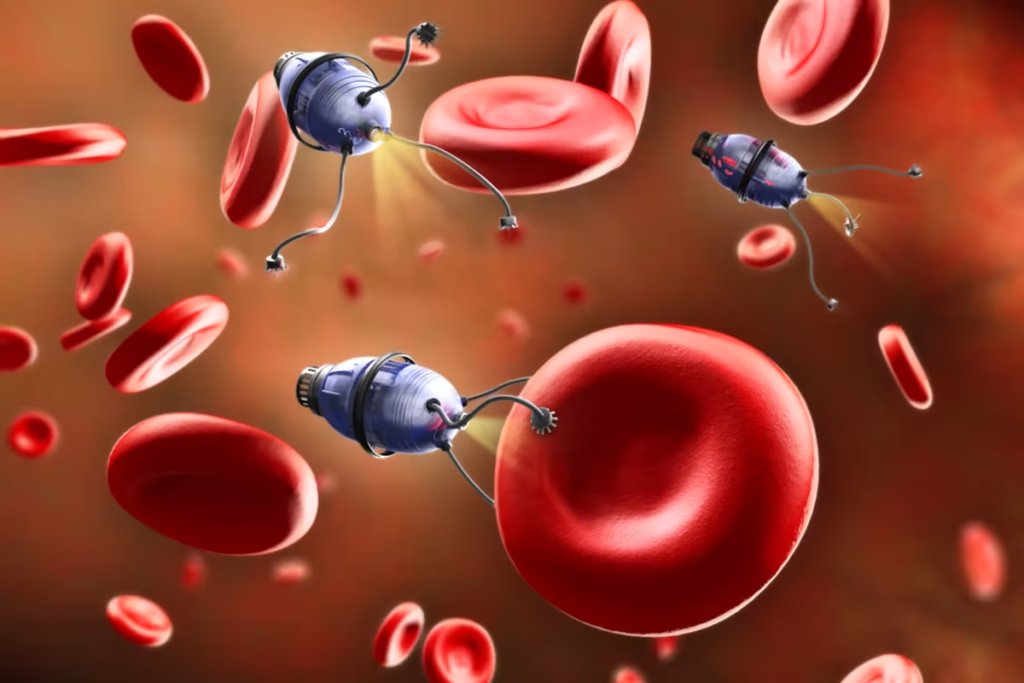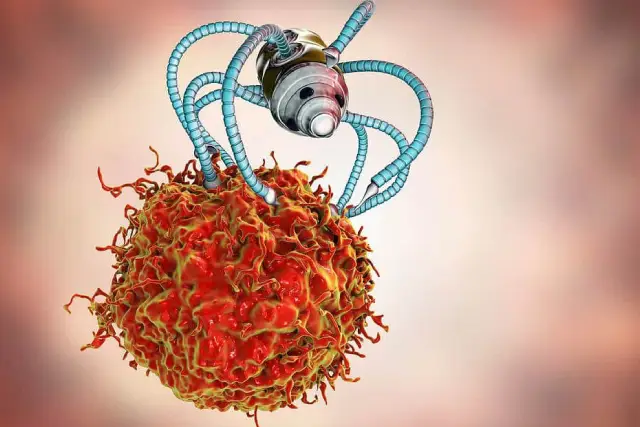Nano-Robots in Cancer Therapy: Revolutionizing Treatment by Targeting Tumors
Nanotechnology is revolutionizing cancer treatment, with nano-robots designed to target and destroy cancer cells, offering a promising alternative to traditional therapies.
In recent years, the convergence of nanotechnology and medicine has led to groundbreaking advancements in cancer treatment. One of the most promising developments is the creation of nano-robots capable of seeking out and destroying cancer cells with precision. These microscopic machines offer hope for more effective and less invasive cancer therapies.
The Rise of Nano-Robots in Cancer Therapy
Nano-robots, often referred to as nanobots or microrobots, are engineered to navigate the human body and deliver therapeutic agents directly to cancer cells. This targeted approach aims to minimize damage to healthy tissues, a common drawback of conventional treatments like chemotherapy and radiation.

How Do Nano-Robots Work?
Nano-robots, or nanobots, are engineered at the nanoscale, typically measuring less than 100 nanometers in size. Their diminutive scale allows them to interact intimately with biological systems, particularly at the cellular and molecular levels. These devices are designed to perform specific tasks within the human body, offering innovative approaches to medical treatment, especially in oncology.
Mechanisms of Action
Targeted Drug Delivery
- Precision Medicine: Nanobots can be programmed to identify and bind to specific biomarkers present on cancer cells. Once attached, they release therapeutic agents directly into the malignant cells, thereby increasing the concentration of the drug at the tumor site while minimizing exposure to healthy tissues. This targeted approach enhances the efficacy of the treatment and reduces systemic side effects commonly associated with conventional chemotherapy.
- Controlled Release Systems: Advanced nanobots are equipped with mechanisms that allow for the controlled release of drugs in response to specific stimuli within the tumor microenvironment, such as pH changes or enzymatic activity. This ensures that the therapeutic agents are released only when and where they are needed, further reducing collateral damage to healthy cells.

Hyperthermia
- Thermal Ablation: Certain nanobots are engineered to convert external energy sources, like near-infrared light or magnetic fields, into heat. When these nanobots accumulate in tumor tissues and are activated, they elevate the local temperature to levels that induce cancer cell death, a process known as hyperthermia. This method selectively destroys cancer cells while sparing surrounding healthy tissue due to the localized heating effect.
- Synergistic Therapies: Combining hyperthermia with other treatments, such as chemotherapy or radiation, can enhance overall therapeutic outcomes. The heat generated by nanobots can increase the permeability of cancer cell membranes, making them more susceptible to chemotherapeutic agents or radiation-induced damage.

Gene Therapy
- Genetic Modification: Nanobots can deliver nucleic acids, such as DNA or RNA, into cancer cells to modulate gene expression. This can involve silencing oncogenes that promote cancer progression or introducing tumor suppressor genes that inhibit cell growth. By directly altering the genetic machinery of cancer cells, gene therapy aims to halt tumor development at its source.
- CRISPR-Cas9 Delivery: The CRISPR-Cas9 gene-editing system can be delivered into cells using nanobots, enabling precise modifications of the genome. This technology holds promise for correcting genetic mutations that drive cancer, offering a potential cure at the molecular level.
Additional Functionalities
- Biosensing and Diagnosis: Nanobots can be equipped with sensors to detect specific molecules associated with cancer, allowing for early diagnosis and real-time monitoring of disease progression. They can transmit data from within the body to external devices, providing clinicians with valuable information on tumor biomarkers and the effectiveness of treatments.
- Minimally Invasive Surgery: Some nanobots are designed to perform tasks akin to microsurgery. They can navigate through the bloodstream to reach tumor sites and deliver therapeutic agents or even physically disrupt cancer cells, reducing the need for invasive surgical procedures.
Powering and Navigation
Nanobots can be powered and guided using various methods:

- Magnetic Fields: Externally applied magnetic fields can direct magnetic nanobots to specific locations within the body. This method allows for precise navigation to tumor sites.
- Chemical Propulsion: Some nanobots utilize chemical reactions with bodily fluids to generate movement, enabling them to autonomously navigate through complex biological environments.
- Acoustic Waves: Ultrasound waves can propel and steer certain types of nanobots, offering another avenue for controlled movement within the body.
Challenges and Future Directions
While the potential of nanobots in cancer therapy is immense, several challenges remain:
- Biocompatibility: Ensuring that nanobots do not elicit adverse immune responses or toxicity is crucial for their safe application in humans.
- Manufacturing Scalability: Producing nanobots with uniform quality and functionality on a large scale poses significant technical challenges.
- Regulatory Approval: Comprehensive clinical trials are necessary to establish the safety and efficacy of nanobot-based therapies, which is a time-consuming and complex process.
Ongoing research is focused on overcoming these hurdles, with the aim of integrating nanobot technology into standard cancer treatment protocols in the future.
In summary, nanobots represent a frontier in cancer therapy, offering innovative solutions for targeted treatment, diagnosis, and potentially curing various forms of cancer. As research progresses, these microscopic machines may become integral tools in the fight against cancer, providing patients with more effective and less invasive treatment options.
Recent Breakthroughs
Researchers at the University of California, San Diego, have developed microrobots capable of swimming through the lungs to deliver cancer-fighting drugs directly to metastatic tumors. In mouse studies, these microrobots inhibited tumor growth and spread, significantly improving survival rates.
Learn more on: sciencedaily.com
Another study highlights the development of microbots thinner than a human hair, designed to deliver drugs directly to cancer cells. These 3D-printed microbots can transition between solid and liquid states, survive in harsh bodily environments, and are eventually expelled naturally. In trials with mice, they effectively reduced the size of bladder tumors, showcasing their potential for future human applications.
Learn more on: thesun.co.uk
Advantages of Nano-Robot-Assisted Cancer Treatment
- Precision: By targeting only cancer cells, nanobots minimize damage to healthy tissues.
- Reduced Side Effects: Targeted delivery reduces the systemic toxicity associated with traditional chemotherapy.
- Enhanced Efficacy: Direct delivery of therapeutic agents can improve treatment outcomes.
Challenges and Future Directions
While the potential of nano-robots in cancer therapy is immense, several challenges remain:
- Biocompatibility: Ensuring that nanobots are safe and do not elicit adverse immune responses.
- Controlled Navigation: Developing reliable methods to guide nanobots to specific sites within the body.
- Scalability: Producing nanobots in sufficient quantities for widespread clinical use.
Ongoing research aims to address these challenges, bringing nano-robot-assisted cancer treatments closer to clinical reality.
Conclusion
The advent of nano-robots in cancer treatment represents a significant leap forward in medical science. As research progresses, these microscopic machines hold the promise of transforming cancer therapy, offering more effective and less invasive treatment options for patients worldwide.







Pingback: The Future of Product Photography and Video Creation: Vmake AI - TechPulsz